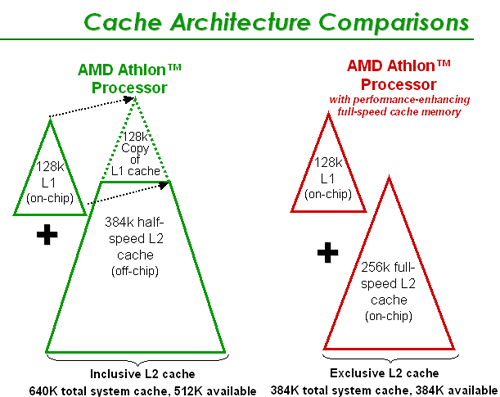AMD Athlon "Thunderbird" 1 GHz / 800 MHz
by Anand Lal Shimpi on June 4, 2000 10:10 PM EST- Posted in
- CPUs
You'll notice that in AMD's press releases, they refer to the Thunderbird as having a total of 384KB of cache. This figure is derived by simply adding the 128KB of L1 cache that the Thunderbird still has from the original Athlon to the 256KB of L2 cache that is now on-die with the Thunderbird.
So what's different about the caching system of the Thunderbird versus that of the Coppermine? AMD is employing an exclusive cache architecture on the Thunderbird instead of the more conventionally used inclusive cache architecture, which is what Intel uses on the Coppermine.
Basically with an inclusive cache, all of the data that is stored in the L1 cache is duplicated in the L2 cache. While the Pentium III (Coppermine) features a 256KB on-die L2 cache, the data contained within its 32KB L1 cache is duplicated in the 256KB L2 cache.
An exclusive cache, which, as you can tell by the name, is the opposite of an inclusive cache, doesn't duplicate L1 data in the L2 cache area. The L2 cache only contains the copy-back cache blocks that are to be written back to the memory sub system (basically everything that doesn't fit in L1 and would normally go to the system memory if there was no L2 cache). Therefore, when AMD claims that the new Thunderbird core has a total of 384KB of on-die cache, they aren't lying; any data in the Athlon's (Thunderbird) 128KB L1 is not duplicated in its 256KB L2.

The Thunderbird still features a 64-bit data path to and from its L2 cache, which is unchanged from the original Athlon. This is a narrower data path than the Pentium III Coppermine's L2 cache has (256-bit vs. 64-bit), which could influence the performance increase the Thunderbird achieves over the original Athlon versus the improvement that we noticed with the Coppermine over the original Pentium III. This offers approximately 1/4 the L2 cache bandwidth of the Pentium III Coppermine which could definitely hinder performance.
Another difference between the Thunderbird's L2 cache and the Coppermine's L2 cache is that the Thunderbird features a 16-way set associative L2 cache whereas the Coppermine features an 8-way set associative L2 cache. What exactly does that mean? In order to explain that we need to take a look at what L2 cache actually does.










0 Comments
View All Comments